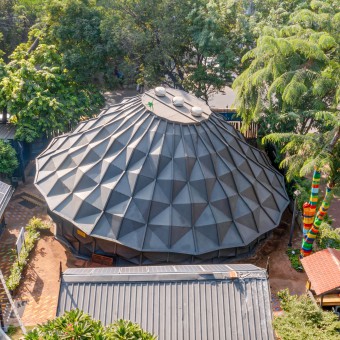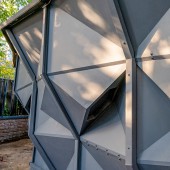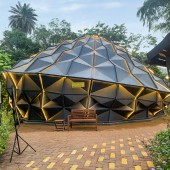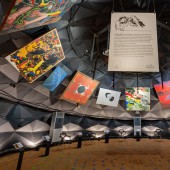
| THE AWARD |
| CATEGORIES |
| REGISTRATION |
| SUBMIT YOUR WORK |
| ENTRY INSTRUCTIONS |
| TERMS & CONDITIONS |
| PUBLICATIONS |
| DATES & FEES |
| METHODOLOGY |
| CONTACT |
| WINNERS |
| PRESS ROOM |
| GET INVOLVED |
| DESIGN PRIZE |
| DESIGN STORE |
| THE AWARD | JURY | CATEGORIES | REGISTRATION | PRESS | WINNERS | PUBLICATIONS | ENTRY INSTRUCTIONS |
Darwin Bucky Exhibition Gallery by Kuber Patel |
Home > Winners > Design #138915 >Interview |
 |
|
FS: What is the main principle, idea and inspiration behind your design?
KP: Bucky is inspired by Buckminster Fuller's geodesic dome. The project is envisioned to be a traveling gallery complemented by its aesthetic architecture for curators to exhibit their work anywhere in the world. One of the major inspirations was to create a gallery that it should be designed for repurposing and can be recycled or deconstructed to minimize unnecessary footprints.
FS: What has been your main focus in designing this work? Especially what did you want to achieve?
KP: The challenge was to construct a typology that works for off-grid areas. The criteria to fit a 10meter span and 6meter height structure into a 6meter container was a difficult task since Bucky was envisioned to be easy to carry around the globe. Adding further, making an open system into a closed system was also a major challenge which was necessary to make the building as watertight as that would ruin the artworks. The windows are designed to have indirect lighting without having rainwater through the opening to protect the painting from any harsh environmental conditions.
FS: What are your future plans for this award winning design?
KP: Bucky was designed with the aim of making a traveling gallery that can be transported anywhere in the world in a 6-meter shipping container. Origami was the basic methodology used to figure out the panel folding of the building and with the help of parametric tools, the fabrication was done onsite. As a result, Bucky was able to fit in a container as well as convert itself into a huge 100-square-meter gallery within a matter of days.
FS: How long did it take you to design this particular concept?
KP: Located in Ahmedabad, Gujarat, India. The project started in October 2019 and was made open to the public in October 2021.
FS: Why did you design this particular concept? Was this design commissioned or did you decide to pursuit an inspiration?
KP: The design was a direct manifestation of the client's vision who wanted a flat-packed structure in the shape of a geodesic dome inspired by Buckminster Fuller's work.
FS: What made you design this particular type of work?
KP: Overall, my architectural style mostly revolves around Performance orientated design that has a strong response to material, structural, social, and environmental behavior.
FS: Where there any other designs and/or designers that helped the influence the design of your work?
KP: The project was influenced by Buckminster Fuller's geodesic dome hence, the name Bucky. The lead architect Jwalant Mahadevwala play an instrumental role in helping shape the project coupled with my skills as a Generative, Algorithmic and Parametric Design consultant.
FS: Who is the target customer for his design?
KP: The structure would be leased to any kind of curator wanting to showcase his/her work in a location around the world. Currently, the structure hosts many cultural events and exhibits artworks.
FS: What sets this design apart from other similar or resembling concepts?
KP: The structure is made using 1mm mild steel spanning a massive 10 meters and 6 meters in height without beams or columns. The Avant grade joinery system makes the structure leakproof and conceals more than 70 percent of the 2800 bolts which is an impossible task to achieve for a component that has naked edges on all four sides as the panels need to be collapsible. The panel size can be easily handled by one person making the assembly extremely efficient.
FS: How did you come up with the name for this design? What does it mean?
KP: The project is influenced by a geodesic dome inspired by Buckminster Fuller hence the name Bucky.
FS: Which design tools did you use when you were working on this project?
KP: Rhino and Grasshopper have been my go-to tools in software as they help me enhance geometrical control over the design. Digital fabrication tools such as metal laser-cutting, robotic sheet folding, and CNC tools also made this project a reality.
FS: What is the most unique aspect of your design?
KP: Galleries is always perceived as a four-walled box. Bucky transforms the way people experience galleries by making the building itself a part of the exhibition. People will interact the same way with the building as they interact with the exhibits inside it.
FS: Who did you collaborate with for this design? Did you work with people with technical / specialized skills?
KP: I collaborated with Abhay Mangaldas and ANDBLACK studio's founder/principal architect Jwalant Mahadevwala. I was the specialist who provided the entire project with Generative, Algorithmic and Parametric Design development fundamental for the project's success.
FS: What is the role of technology in this particular design?
KP: Our design style is influenced more by the process of emergence. With the advancement of computational tools like Generative, Algorithmic, and Parametric Design we now have the ability to look at designs quantitatively rather than qualitatively. The idea is that during the design process we have local-level control over each aspect of the design. Through a parametrically driven model, you have a schematic idea of the final result and the final output is always emergent. Here the design is controlled through criteria and parameters at various scales setting up a process of emergence.
FS: Is your design influenced by data or analytical research in any way? What kind of research did you conduct for making this design?
KP: The system evolved from a series of studies done on origami to make the metal sheets rigid through strategic folding. Circular shape of Bucky is a direct representation of Buckminster Fuller's geodesic dome which helps with structural performance and the forgiving geometrical form in case of human error during assembly.
FS: What are some of the challenges you faced during the design/realization of your concept?
KP: The mathematical precision of the bolting joinery between each panel as they rotate along the circumference was successfully executed as we had a parametric model. Since the system had to flat-pack structure design the details in a way to keep the panel have no water seepage was the biggest challenge we faced during design development.
FS: How did you decide to submit your design to an international design competition?
KP: A' Design Award is a very prestigious banner and our company was waiting for the right project that could represent us in an international design competition.
FS: What did you learn or how did you improve yourself during the designing of this work?
KP: I learned python coding and advance scripting through a platform called Grasshopper3d to develop a precise model leaving zero room for error. This was necessary as all panels had to be planar moving along a curved surface where each panel had to be bolted form all sides.
FS: Thank you for providing us with this opportunity to interview you.
A' Design Award and Competitions grants rights to press members and bloggers to use parts of this interview. This interview is provided as it is; DesignPRWire and A' Design Award and Competitions cannot be held responsible for the answers given by participating designers.
| SOCIAL |
| + Add to Likes / Favorites | Send to My Email | Comment | View Press-Release | Translations |





